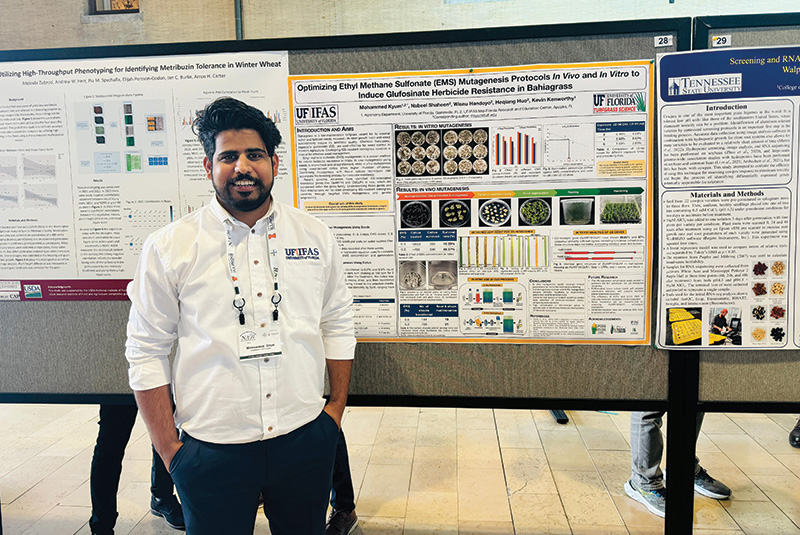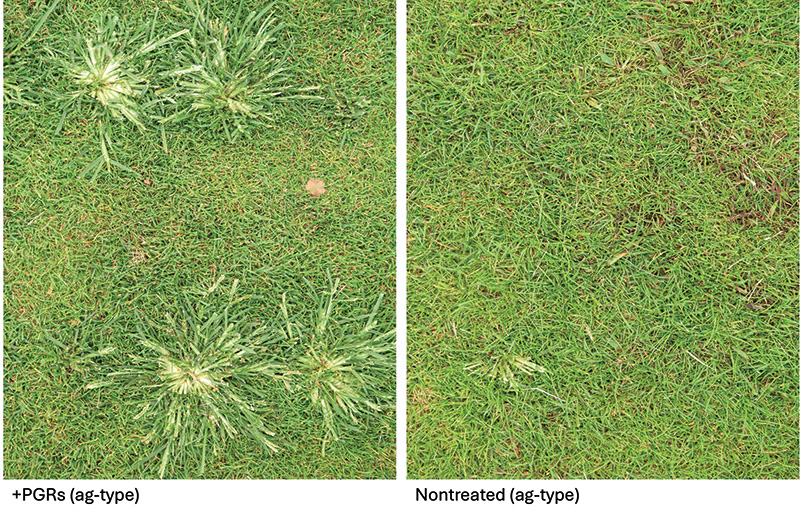
Optimizing ethyl methane sulfonate mutagenesis protocols to induce glufosinate herbicide resistance in bahiagrass
Bahiagrass (Paspalum notatum), a low-maintenance turfgrass, is valued for its minimal water and fertilizer needs. However, its susceptibility to weeds reduces its aesthetic value and quality. Ethyl methane sulfonate (EMS) mutagenesis has proved useful for inducing herbicide tolerance in other crops. This study aimed to determine the optimal EMS treatments to induce glufosinate resistance in bahiagrass through exposure to seed (in vivo) and callus (in vitro). For EMS treatment of seed, five EMS concentrations (1%, 2%, 3%, 4% and 6% v/v) were tested across three exposure times (two hours, four hours and six hours). For callus, two EMS regimens (0.2% for two hours and 0.5% for five hours) were applied to 2-month-old callus derived from mature seeds. Non-treated seeds and callus served as controls. Germination rates and seedling survival were recorded for the seed treatments, as well as the number of viable calli after two weeks for the callus treatments.
A decline in germination, survival and callus viability was observed with increasing EMS concentration and exposure duration. The lethal dose 50 (LD-50) was identified as 2.5% EMS for four hours in seed treatments and 0.2% EMS for two hours in callus treatments. Callus treated with 0.2% EMS regenerated plants like untreated callus with minimal albino phenotypes, compared to those treated with 0.5% EMS. Putative resistant plants were identified in rooting media (MS) supplemented with 5 micromoles glufosinate. TILLING (Targeting Induced Local Lesions in Genomes) populations were generated from both experiments based on the respective LD-50 doses to screen for single nucleotide polymorphisms (SNPs) in genes related to glufosinate tolerance, specifically glutamine synthase (GS)1, GS2 and the recently reported OsARF18 (Oryza sativa Auxin Response Factor 18) orthologue in bahiagrass (PnARF18). This study provides a protocol for EMS-induced mutagenesis in bahiagrass.
— Mohammed Kyum, Ph.D. (mkyum@ufl.edu), Agronomy Department, University of Florida, Gainesville, and UF/IFAS Mid-Florida Research and Education Center, Apopka; Nabeel Shaheen, Wisnu Handoyo and Heqiang Huo, UF/IFAS Mid-Florida Research and Education Center; and Kevin Kenworthy, Agronomy Department, University of Florida

Cultural management and plant growth regulators affect competitiveness of goosegrass ecotypes in turfgrass
The objective is to determine effects of mowing height, nitrogen (N) and plant growth regulator (PGR) on the competitiveness of two goosegrass ecotypes in turfgrass. Treatments of PGR (trinexapac-ethyl at 2.71 ounces per acre/190 grams per hectare or no PGR), nitrogen fertilizer (0 or 22.3 pounds N per acre/0 or 25 kilograms per hectare), and goosegrass ecotype (turf-type and ag-type), imposed with strips of mowing height (0.79 and 1.57 inches/2.0 and 4.0 centimeters), were arranged as a strip-plot RCBD with four replications. Nitrogen and PGR applications were made every 21 days from May until September 2023. A preliminary garden experiment found morphologically distinct goosegrass ecotypes collected from golf course fairway and row-crop goosegrass populations. Goosegrass ecotypes were installed on July 10 as leaf-stage seedlings. Turf density was evaluated monthly.
In 2023, effects of cultural management and ecotype were significant. Mowing height did not affect goosegrass biomass or cover. Nitrogen reduced cover and biomass of turf ecotypes by greater than 50% compared to the nonfertilized. PGR increased biomass of both the ag and turf ecotypes (by 31% and 549%) compared to the non-treated. Turf ecotypes treated with PGR had the greatest biomass of all treatments. N+PGR reduced biomass of turf ecotypes by 23% and increased biomass of ag ecotypes to 234% compared to the untreated. This research shows the PGR trinexapac-ethyl can increase the competitiveness of goosegrass in turf, despite having a positive effect on turfgrass density. Trinexapac-ethyl increased the competitiveness of ag ecotypes more than turf ecotypes. Nitrogen reduced goosegrass competitiveness overall, but effects varied by ecotype. This study is being repeated in 2024.
— Katherine Diehl (katherine.diehl@rutgers.edu) and Matthew Elmore, Ph.D., Rutgers University, New Brunswick, N.J.
Darrell J. Pehr (dpehr@gcsaa.org) is GCM’s science editor.